

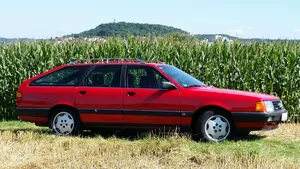
1990 100 Avant (4A,C4)
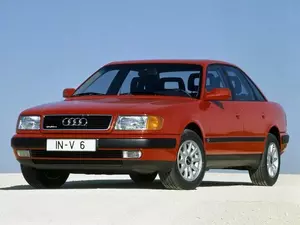
1990 100 (4A,C4)
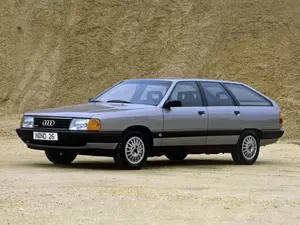
1988 100 Avant (C3, Typ 44, 44Q, facelift 1988)
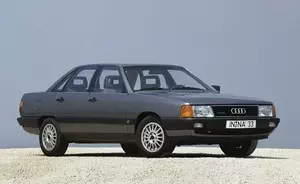
1988 100 (C3, Typ 44,44Q, facelift 1988)
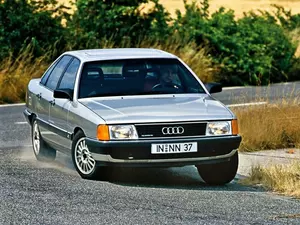
1982 100 (C3, Typ 44,44Q)
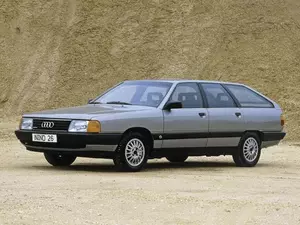
1982 100 Avant (C3, Typ 44, 44Q)
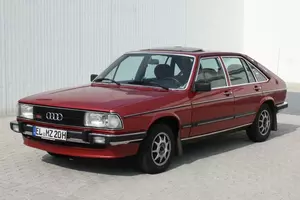
1979 100 Avant (C2, Typ 43, facelift 1979)
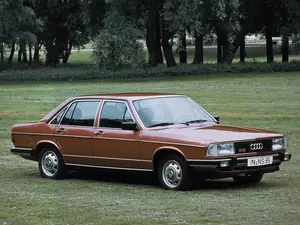
1979 100 (C2, Typ 43, facelift 1979)

1976 100 (C2, Typ 43)
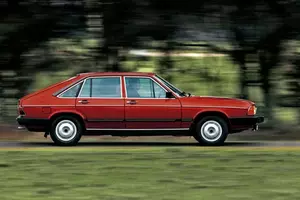
1977 100 Avant (C2, Typ 43)
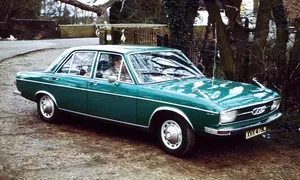
1974 100 (C1, facelift 1973)
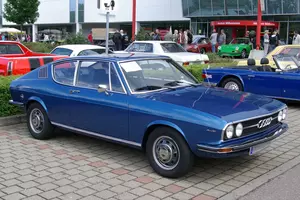
1970 100 Coupe S
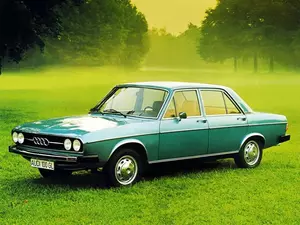
1968 100 (C1)

| Vehicle | Curb weight | Difference from world's smallest | Weight to power ratio | 0—60 mph acceleration ratio | Consumption ratio |
|---|---|---|---|---|---|
| 2.0 16V |
1375 kg / 3032 lbs |
950 kg (2095 lbs) heavier | 10 kg to 1 hp | 139 kg/s (306 lbs/s) |
176 kg/L (388 lbs/L) |
| 2.6 V6 |
1550 kg / 3418 lbs |
1125 kg (2481 lbs) heavier | 10 kg to 1 hp | 163 kg/s (359 lbs/s) |
127 kg/L (280 lbs/L) |
| 2.8 V6 E |
1550 kg / 3418 lbs |
1125 kg (2481 lbs) heavier | 9 kg to 1 hp | - |
155 kg/L (342 lbs/L) |
| 2.8 E |
1450 kg / 3197 lbs |
1025 kg (2260 lbs) heavier | 8 kg to 1 hp | 161 kg/s (355 lbs/s) |
158 kg/L (348 lbs/L) |
| 2.3 E |
1520 kg / 3352 lbs |
1095 kg (2415 lbs) heavier | 11 kg to 1 hp | 149 kg/s (329 lbs/s) |
158 kg/L (348 lbs/L) |
| 2.5 TDI |
1475 kg / 3252 lbs |
1050 kg (2315 lbs) heavier | 13 kg to 1 hp | 134 kg/s (295 lbs/s) |
220 kg/L (485 lbs/L) |
| 2.0 E |
1480 kg / 3263 lbs |
1055 kg (2326 lbs) heavier | 13 kg to 1 hp | 131 kg/s (289 lbs/s) |
174 kg/L (384 lbs/L) |
| 2.2 S4 Turbo |
1660 kg / 3660 lbs |
1235 kg (2723 lbs) heavier | 7 kg to 1 hp | 248 kg/s (547 lbs/s) |
166 kg/L (366 lbs/L) |
| 2.0 |
1360 kg / 2999 lbs |
935 kg (2062 lbs) heavier | 13 kg to 1 hp | 110 kg/s (243 lbs/s) |
168 kg/L (370 lbs/L) |
| 2.4 D |
1435 kg / 3164 lbs |
1010 kg (2227 lbs) heavier | 18 kg to 1 hp | 86 kg/s (190 lbs/s) |
191 kg/L (421 lbs/L) |
| Vehicle | 2.0 16V |
|---|---|
| Curb weight |
1375 kg / 3032 lbs |
| Difference from world's smallest | 950 kg (950 lbs) heavier |
| Weight to power ratio | 10 kg to 1 hp |
| 0—60 mph acceleration ratio | 139 kg/s (306 lbs/s) |
| Consumption ratio |
176 kg/L (388 lbs/L) |
| Vehicle | 2.6 V6 |
| Curb weight |
1550 kg / 3418 lbs |
| Difference from world's smallest | 1125 kg (1125 lbs) heavier |
| Weight to power ratio | 10 kg to 1 hp |
| 0—60 mph acceleration ratio | 163 kg/s (359 lbs/s) |
| Consumption ratio |
127 kg/L (280 lbs/L) |
| Vehicle | 2.8 V6 E |
| Curb weight |
1550 kg / 3418 lbs |
| Difference from world's smallest | 1125 kg (1125 lbs) heavier |
| Weight to power ratio | 9 kg to 1 hp |
| 0—60 mph acceleration ratio | - |
| Consumption ratio |
155 kg/L (342 lbs/L) |
| Vehicle | 2.8 E |
| Curb weight |
1450 kg / 3197 lbs |
| Difference from world's smallest | 1025 kg (1025 lbs) heavier |
| Weight to power ratio | 8 kg to 1 hp |
| 0—60 mph acceleration ratio | 161 kg/s (355 lbs/s) |
| Consumption ratio |
158 kg/L (348 lbs/L) |
| Vehicle | 2.3 E |
| Curb weight |
1520 kg / 3352 lbs |
| Difference from world's smallest | 1095 kg (1095 lbs) heavier |
| Weight to power ratio | 11 kg to 1 hp |
| 0—60 mph acceleration ratio | 149 kg/s (329 lbs/s) |
| Consumption ratio |
158 kg/L (348 lbs/L) |
| Vehicle | 2.5 TDI |
| Curb weight |
1475 kg / 3252 lbs |
| Difference from world's smallest | 1050 kg (1050 lbs) heavier |
| Weight to power ratio | 13 kg to 1 hp |
| 0—60 mph acceleration ratio | 134 kg/s (295 lbs/s) |
| Consumption ratio |
220 kg/L (485 lbs/L) |
| Vehicle | 2.0 E |
| Curb weight |
1480 kg / 3263 lbs |
| Difference from world's smallest | 1055 kg (1055 lbs) heavier |
| Weight to power ratio | 13 kg to 1 hp |
| 0—60 mph acceleration ratio | 131 kg/s (289 lbs/s) |
| Consumption ratio |
174 kg/L (384 lbs/L) |
| Vehicle | 2.2 S4 Turbo |
| Curb weight |
1660 kg / 3660 lbs |
| Difference from world's smallest | 1235 kg (1235 lbs) heavier |
| Weight to power ratio | 7 kg to 1 hp |
| 0—60 mph acceleration ratio | 248 kg/s (547 lbs/s) |
| Consumption ratio |
166 kg/L (366 lbs/L) |
| Vehicle | 2.0 |
| Curb weight |
1360 kg / 2999 lbs |
| Difference from world's smallest | 935 kg (935 lbs) heavier |
| Weight to power ratio | 13 kg to 1 hp |
| 0—60 mph acceleration ratio | 110 kg/s (243 lbs/s) |
| Consumption ratio |
168 kg/L (370 lbs/L) |
| Vehicle | 2.4 D |
| Curb weight |
1435 kg / 3164 lbs |
| Difference from world's smallest | 1010 kg (1010 lbs) heavier |
| Weight to power ratio | 18 kg to 1 hp |
| 0—60 mph acceleration ratio | 86 kg/s (190 lbs/s) |
| Consumption ratio |
191 kg/L (421 lbs/L) |

| Vehicle | Curb weight | Difference from world's smallest | Weight to power ratio | 0—60 mph acceleration ratio | Consumption ratio |
|---|---|---|---|---|---|
| 2.8 V6 E |
1400 kg / 3087 lbs |
975 kg (2150 lbs) heavier | 8 kg to 1 hp | 184 kg/s (406 lbs/s) |
163 kg/L (359 lbs/L) |
| 2.6 V6 |
1400 kg / 3087 lbs |
975 kg (2150 lbs) heavier | 9 kg to 1 hp | 156 kg/s (344 lbs/s) |
161 kg/L (355 lbs/L) |
| 2.5 TDI |
1425 kg / 3142 lbs |
1000 kg (2205 lbs) heavier | 12 kg to 1 hp | 136 kg/s (300 lbs/s) |
234 kg/L (516 lbs/L) |
| 2.3 E |
1470 kg / 3241 lbs |
1045 kg (2304 lbs) heavier | 11 kg to 1 hp | 148 kg/s (326 lbs/s) |
153 kg/L (337 lbs/L) |
| 2.0 |
1310 kg / 2889 lbs |
885 kg (1952 lbs) heavier | 13 kg to 1 hp | 109 kg/s (240 lbs/s) |
168 kg/L (370 lbs/L) |
| 2.0 E |
1430 kg / 3153 lbs |
1005 kg (2216 lbs) heavier | 12 kg to 1 hp | 132 kg/s (291 lbs/s) |
168 kg/L (370 lbs/L) |
| 2.0 E 16V |
1370 kg / 3021 lbs |
945 kg (2084 lbs) heavier | 10 kg to 1 hp | 143 kg/s (315 lbs/s) |
144 kg/L (318 lbs/L) |
| 2.4 D |
1385 kg / 3054 lbs |
960 kg (2117 lbs) heavier | 17 kg to 1 hp | 87 kg/s (192 lbs/s) |
192 kg/L (423 lbs/L) |
| Vehicle | 2.8 V6 E |
|---|---|
| Curb weight |
1400 kg / 3087 lbs |
| Difference from world's smallest | 975 kg (975 lbs) heavier |
| Weight to power ratio | 8 kg to 1 hp |
| 0—60 mph acceleration ratio | 184 kg/s (406 lbs/s) |
| Consumption ratio |
163 kg/L (359 lbs/L) |
| Vehicle | 2.6 V6 |
| Curb weight |
1400 kg / 3087 lbs |
| Difference from world's smallest | 975 kg (975 lbs) heavier |
| Weight to power ratio | 9 kg to 1 hp |
| 0—60 mph acceleration ratio | 156 kg/s (344 lbs/s) |
| Consumption ratio |
161 kg/L (355 lbs/L) |
| Vehicle | 2.5 TDI |
| Curb weight |
1425 kg / 3142 lbs |
| Difference from world's smallest | 1000 kg (1000 lbs) heavier |
| Weight to power ratio | 12 kg to 1 hp |
| 0—60 mph acceleration ratio | 136 kg/s (300 lbs/s) |
| Consumption ratio |
234 kg/L (516 lbs/L) |
| Vehicle | 2.3 E |
| Curb weight |
1470 kg / 3241 lbs |
| Difference from world's smallest | 1045 kg (1045 lbs) heavier |
| Weight to power ratio | 11 kg to 1 hp |
| 0—60 mph acceleration ratio | 148 kg/s (326 lbs/s) |
| Consumption ratio |
153 kg/L (337 lbs/L) |
| Vehicle | 2.0 |
| Curb weight |
1310 kg / 2889 lbs |
| Difference from world's smallest | 885 kg (885 lbs) heavier |
| Weight to power ratio | 13 kg to 1 hp |
| 0—60 mph acceleration ratio | 109 kg/s (240 lbs/s) |
| Consumption ratio |
168 kg/L (370 lbs/L) |
| Vehicle | 2.0 E |
| Curb weight |
1430 kg / 3153 lbs |
| Difference from world's smallest | 1005 kg (1005 lbs) heavier |
| Weight to power ratio | 12 kg to 1 hp |
| 0—60 mph acceleration ratio | 132 kg/s (291 lbs/s) |
| Consumption ratio |
168 kg/L (370 lbs/L) |
| Vehicle | 2.0 E 16V |
| Curb weight |
1370 kg / 3021 lbs |
| Difference from world's smallest | 945 kg (945 lbs) heavier |
| Weight to power ratio | 10 kg to 1 hp |
| 0—60 mph acceleration ratio | 143 kg/s (315 lbs/s) |
| Consumption ratio |
144 kg/L (318 lbs/L) |
| Vehicle | 2.4 D |
| Curb weight |
1385 kg / 3054 lbs |
| Difference from world's smallest | 960 kg (960 lbs) heavier |
| Weight to power ratio | 17 kg to 1 hp |
| 0—60 mph acceleration ratio | 87 kg/s (192 lbs/s) |
| Consumption ratio |
192 kg/L (423 lbs/L) |

| Vehicle | Curb weight | Difference from world's smallest | Weight to power ratio | 0—60 mph acceleration ratio | Consumption ratio |
|---|---|---|---|---|---|
| 2.3 CAT |
1290 kg / 2844 lbs |
865 kg (1907 lbs) heavier | 9 kg to 1 hp | 136 kg/s (300 lbs/s) |
122 kg/L (269 lbs/L) |
| 2.0 TD |
1340 kg / 2955 lbs |
915 kg (2018 lbs) heavier | 13 kg to 1 hp | 110 kg/s (243 lbs/s) |
172 kg/L (379 lbs/L) |
| 2.0 E CAT |
1290 kg / 2844 lbs |
865 kg (1907 lbs) heavier | 11 kg to 1 hp | 124 kg/s (273 lbs/s) |
132 kg/L (291 lbs/L) |
| 2.0 D |
1290 kg / 2844 lbs |
865 kg (1907 lbs) heavier | 18 kg to 1 hp | 70 kg/s (154 lbs/s) |
193 kg/L (426 lbs/L) |
| 2.3 |
1400 kg / 3087 lbs |
975 kg (2150 lbs) heavier | 10 kg to 1 hp | 144 kg/s (318 lbs/s) |
123 kg/L (271 lbs/L) |
| 2.2 Turbo CAT |
1450 kg / 3197 lbs |
1025 kg (2260 lbs) heavier | 9 kg to 1 hp | 186 kg/s (410 lbs/s) |
127 kg/L (280 lbs/L) |
| 1.8 |
1310 kg / 2889 lbs |
885 kg (1952 lbs) heavier | 15 kg to 1 hp | 102 kg/s (225 lbs/s) |
112 kg/L (247 lbs/L) |
| 1.8 CAT |
1310 kg / 2889 lbs |
885 kg (1952 lbs) heavier | 15 kg to 1 hp | 102 kg/s (225 lbs/s) |
138 kg/L (304 lbs/L) |
| 2.2 CAT |
1290 kg / 2844 lbs |
865 kg (1907 lbs) heavier | 9 kg to 1 hp | 139 kg/s (306 lbs/s) |
147 kg/L (324 lbs/L) |
| 2.2 |
1400 kg / 3087 lbs |
975 kg (2150 lbs) heavier | 10 kg to 1 hp | - |
146 kg/L (322 lbs/L) |
| 2.4 D |
1340 kg / 2955 lbs |
915 kg (2018 lbs) heavier | 16 kg to 1 hp | 83 kg/s (183 lbs/s) |
156 kg/L (344 lbs/L) |
| 2.5 TDI |
1360 kg / 2999 lbs |
935 kg (2062 lbs) heavier | 11 kg to 1 hp | 142 kg/s (313 lbs/s) |
166 kg/L (366 lbs/L) |
| Vehicle | 2.3 CAT |
|---|---|
| Curb weight |
1290 kg / 2844 lbs |
| Difference from world's smallest | 865 kg (865 lbs) heavier |
| Weight to power ratio | 9 kg to 1 hp |
| 0—60 mph acceleration ratio | 136 kg/s (300 lbs/s) |
| Consumption ratio |
122 kg/L (269 lbs/L) |
| Vehicle | 2.0 TD |
| Curb weight |
1340 kg / 2955 lbs |
| Difference from world's smallest | 915 kg (915 lbs) heavier |
| Weight to power ratio | 13 kg to 1 hp |
| 0—60 mph acceleration ratio | 110 kg/s (243 lbs/s) |
| Consumption ratio |
172 kg/L (379 lbs/L) |
| Vehicle | 2.0 E CAT |
| Curb weight |
1290 kg / 2844 lbs |
| Difference from world's smallest | 865 kg (865 lbs) heavier |
| Weight to power ratio | 11 kg to 1 hp |
| 0—60 mph acceleration ratio | 124 kg/s (273 lbs/s) |
| Consumption ratio |
132 kg/L (291 lbs/L) |
| Vehicle | 2.0 D |
| Curb weight |
1290 kg / 2844 lbs |
| Difference from world's smallest | 865 kg (865 lbs) heavier |
| Weight to power ratio | 18 kg to 1 hp |
| 0—60 mph acceleration ratio | 70 kg/s (154 lbs/s) |
| Consumption ratio |
193 kg/L (426 lbs/L) |
| Vehicle | 2.3 |
| Curb weight |
1400 kg / 3087 lbs |
| Difference from world's smallest | 975 kg (975 lbs) heavier |
| Weight to power ratio | 10 kg to 1 hp |
| 0—60 mph acceleration ratio | 144 kg/s (318 lbs/s) |
| Consumption ratio |
123 kg/L (271 lbs/L) |
| Vehicle | 2.2 Turbo CAT |
| Curb weight |
1450 kg / 3197 lbs |
| Difference from world's smallest | 1025 kg (1025 lbs) heavier |
| Weight to power ratio | 9 kg to 1 hp |
| 0—60 mph acceleration ratio | 186 kg/s (410 lbs/s) |
| Consumption ratio |
127 kg/L (280 lbs/L) |
| Vehicle | 1.8 |
| Curb weight |
1310 kg / 2889 lbs |
| Difference from world's smallest | 885 kg (885 lbs) heavier |
| Weight to power ratio | 15 kg to 1 hp |
| 0—60 mph acceleration ratio | 102 kg/s (225 lbs/s) |
| Consumption ratio |
112 kg/L (247 lbs/L) |
| Vehicle | 1.8 CAT |
| Curb weight |
1310 kg / 2889 lbs |
| Difference from world's smallest | 885 kg (885 lbs) heavier |
| Weight to power ratio | 15 kg to 1 hp |
| 0—60 mph acceleration ratio | 102 kg/s (225 lbs/s) |
| Consumption ratio |
138 kg/L (304 lbs/L) |
| Vehicle | 2.2 CAT |
| Curb weight |
1290 kg / 2844 lbs |
| Difference from world's smallest | 865 kg (865 lbs) heavier |
| Weight to power ratio | 9 kg to 1 hp |
| 0—60 mph acceleration ratio | 139 kg/s (306 lbs/s) |
| Consumption ratio |
147 kg/L (324 lbs/L) |
| Vehicle | 2.2 |
| Curb weight |
1400 kg / 3087 lbs |
| Difference from world's smallest | 975 kg (975 lbs) heavier |
| Weight to power ratio | 10 kg to 1 hp |
| 0—60 mph acceleration ratio | - |
| Consumption ratio |
146 kg/L (322 lbs/L) |
| Vehicle | 2.4 D |
| Curb weight |
1340 kg / 2955 lbs |
| Difference from world's smallest | 915 kg (915 lbs) heavier |
| Weight to power ratio | 16 kg to 1 hp |
| 0—60 mph acceleration ratio | 83 kg/s (183 lbs/s) |
| Consumption ratio |
156 kg/L (344 lbs/L) |
| Vehicle | 2.5 TDI |
| Curb weight |
1360 kg / 2999 lbs |
| Difference from world's smallest | 935 kg (935 lbs) heavier |
| Weight to power ratio | 11 kg to 1 hp |
| 0—60 mph acceleration ratio | 142 kg/s (313 lbs/s) |
| Consumption ratio |
166 kg/L (366 lbs/L) |

| Vehicle | Curb weight | Difference from world's smallest | Weight to power ratio | 0—60 mph acceleration ratio | Consumption ratio |
|---|---|---|---|---|---|
| 1.8 |
1270 kg / 2800 lbs |
845 kg (1863 lbs) heavier | 14 kg to 1 hp | 102 kg/s (225 lbs/s) |
109 kg/L (240 lbs/L) |
| 2.2 Turbo CAT |
1410 kg / 3109 lbs |
985 kg (2172 lbs) heavier | 9 kg to 1 hp | 186 kg/s (410 lbs/s) |
131 kg/L (289 lbs/L) |
| 2.2 Turbo |
1080 kg / 2381 lbs |
655 kg (1444 lbs) heavier | 6 kg to 1 hp | - | - |
| 2.3 E CAT |
1250 kg / 2756 lbs |
825 kg (1819 lbs) heavier | 9 kg to 1 hp | 134 kg/s (295 lbs/s) |
140 kg/L (309 lbs/L) |
| 2.0 D |
1250 kg / 2756 lbs |
825 kg (1819 lbs) heavier | 18 kg to 1 hp | 71 kg/s (157 lbs/s) |
187 kg/L (412 lbs/L) |
| 2.0 D Turbo |
1300 kg / 2867 lbs |
875 kg (1930 lbs) heavier | 13 kg to 1 hp | 111 kg/s (245 lbs/s) |
194 kg/L (428 lbs/L) |
| 2.0 E |
1250 kg / 2756 lbs |
825 kg (1819 lbs) heavier | 11 kg to 1 hp | 123 kg/s (271 lbs/s) |
142 kg/L (313 lbs/L) |
| 1.8 CAT |
1270 kg / 2800 lbs |
845 kg (1863 lbs) heavier | 14 kg to 1 hp | 102 kg/s (225 lbs/s) |
140 kg/L (309 lbs/L) |
| 2.0 E CAT |
1250 kg / 2756 lbs |
825 kg (1819 lbs) heavier | 11 kg to 1 hp | 123 kg/s (271 lbs/s) |
140 kg/L (309 lbs/L) |
| 2.2 E |
1250 kg / 2756 lbs |
825 kg (1819 lbs) heavier | 9 kg to 1 hp | 137 kg/s (302 lbs/s) |
142 kg/L (313 lbs/L) |
| 2.2 CAT |
1360 kg / 2999 lbs |
935 kg (2062 lbs) heavier | 10 kg to 1 hp | 146 kg/s (322 lbs/s) |
142 kg/L (313 lbs/L) |
| 2.3 E |
1360 kg / 2999 lbs |
935 kg (2062 lbs) heavier | 10 kg to 1 hp | 143 kg/s (315 lbs/s) |
148 kg/L (326 lbs/L) |
| 2.4 D |
1300 kg / 2867 lbs |
875 kg (1930 lbs) heavier | 16 kg to 1 hp | 83 kg/s (183 lbs/s) |
183 kg/L (404 lbs/L) |
| 2.5 TDI |
1320 kg / 2911 lbs |
895 kg (1974 lbs) heavier | 11 kg to 1 hp | 140 kg/s (309 lbs/s) |
220 kg/L (485 lbs/L) |
| 2.3 |
1360 kg / 2999 lbs |
935 kg (2062 lbs) heavier | 10 kg to 1 hp | 143 kg/s (315 lbs/s) |
148 kg/L (326 lbs/L) |
| Vehicle | 1.8 |
|---|---|
| Curb weight |
1270 kg / 2800 lbs |
| Difference from world's smallest | 845 kg (845 lbs) heavier |
| Weight to power ratio | 14 kg to 1 hp |
| 0—60 mph acceleration ratio | 102 kg/s (225 lbs/s) |
| Consumption ratio |
109 kg/L (240 lbs/L) |
| Vehicle | 2.2 Turbo CAT |
| Curb weight |
1410 kg / 3109 lbs |
| Difference from world's smallest | 985 kg (985 lbs) heavier |
| Weight to power ratio | 9 kg to 1 hp |
| 0—60 mph acceleration ratio | 186 kg/s (410 lbs/s) |
| Consumption ratio |
131 kg/L (289 lbs/L) |
| Vehicle | 2.2 Turbo |
| Curb weight |
1080 kg / 2381 lbs |
| Difference from world's smallest | 655 kg (655 lbs) heavier |
| Weight to power ratio | 6 kg to 1 hp |
| 0—60 mph acceleration ratio | - |
| Consumption ratio | - |
| Vehicle | 2.3 E CAT |
| Curb weight |
1250 kg / 2756 lbs |
| Difference from world's smallest | 825 kg (825 lbs) heavier |
| Weight to power ratio | 9 kg to 1 hp |
| 0—60 mph acceleration ratio | 134 kg/s (295 lbs/s) |
| Consumption ratio |
140 kg/L (309 lbs/L) |
| Vehicle | 2.0 D |
| Curb weight |
1250 kg / 2756 lbs |
| Difference from world's smallest | 825 kg (825 lbs) heavier |
| Weight to power ratio | 18 kg to 1 hp |
| 0—60 mph acceleration ratio | 71 kg/s (157 lbs/s) |
| Consumption ratio |
187 kg/L (412 lbs/L) |
| Vehicle | 2.0 D Turbo |
| Curb weight |
1300 kg / 2867 lbs |
| Difference from world's smallest | 875 kg (875 lbs) heavier |
| Weight to power ratio | 13 kg to 1 hp |
| 0—60 mph acceleration ratio | 111 kg/s (245 lbs/s) |
| Consumption ratio |
194 kg/L (428 lbs/L) |
| Vehicle | 2.0 E |
| Curb weight |
1250 kg / 2756 lbs |
| Difference from world's smallest | 825 kg (825 lbs) heavier |
| Weight to power ratio | 11 kg to 1 hp |
| 0—60 mph acceleration ratio | 123 kg/s (271 lbs/s) |
| Consumption ratio |
142 kg/L (313 lbs/L) |
| Vehicle | 1.8 CAT |
| Curb weight |
1270 kg / 2800 lbs |
| Difference from world's smallest | 845 kg (845 lbs) heavier |
| Weight to power ratio | 14 kg to 1 hp |
| 0—60 mph acceleration ratio | 102 kg/s (225 lbs/s) |
| Consumption ratio |
140 kg/L (309 lbs/L) |
| Vehicle | 2.0 E CAT |
| Curb weight |
1250 kg / 2756 lbs |
| Difference from world's smallest | 825 kg (825 lbs) heavier |
| Weight to power ratio | 11 kg to 1 hp |
| 0—60 mph acceleration ratio | 123 kg/s (271 lbs/s) |
| Consumption ratio |
140 kg/L (309 lbs/L) |
| Vehicle | 2.2 E |
| Curb weight |
1250 kg / 2756 lbs |
| Difference from world's smallest | 825 kg (825 lbs) heavier |
| Weight to power ratio | 9 kg to 1 hp |
| 0—60 mph acceleration ratio | 137 kg/s (302 lbs/s) |
| Consumption ratio |
142 kg/L (313 lbs/L) |
| Vehicle | 2.2 CAT |
| Curb weight |
1360 kg / 2999 lbs |
| Difference from world's smallest | 935 kg (935 lbs) heavier |
| Weight to power ratio | 10 kg to 1 hp |
| 0—60 mph acceleration ratio | 146 kg/s (322 lbs/s) |
| Consumption ratio |
142 kg/L (313 lbs/L) |
| Vehicle | 2.3 E |
| Curb weight |
1360 kg / 2999 lbs |
| Difference from world's smallest | 935 kg (935 lbs) heavier |
| Weight to power ratio | 10 kg to 1 hp |
| 0—60 mph acceleration ratio | 143 kg/s (315 lbs/s) |
| Consumption ratio |
148 kg/L (326 lbs/L) |
| Vehicle | 2.4 D |
| Curb weight |
1300 kg / 2867 lbs |
| Difference from world's smallest | 875 kg (875 lbs) heavier |
| Weight to power ratio | 16 kg to 1 hp |
| 0—60 mph acceleration ratio | 83 kg/s (183 lbs/s) |
| Consumption ratio |
183 kg/L (404 lbs/L) |
| Vehicle | 2.5 TDI |
| Curb weight |
1320 kg / 2911 lbs |
| Difference from world's smallest | 895 kg (895 lbs) heavier |
| Weight to power ratio | 11 kg to 1 hp |
| 0—60 mph acceleration ratio | 140 kg/s (309 lbs/s) |
| Consumption ratio |
220 kg/L (485 lbs/L) |
| Vehicle | 2.3 |
| Curb weight |
1360 kg / 2999 lbs |
| Difference from world's smallest | 935 kg (935 lbs) heavier |
| Weight to power ratio | 10 kg to 1 hp |
| 0—60 mph acceleration ratio | 143 kg/s (315 lbs/s) |
| Consumption ratio |
148 kg/L (326 lbs/L) |

| Vehicle | Curb weight | Difference from world's smallest | Weight to power ratio | 0—60 mph acceleration ratio | Consumption ratio |
|---|---|---|---|---|---|
| 2.2 E Turbo |
1410 kg / 3109 lbs |
985 kg (2172 lbs) heavier | 9 kg to 1 hp | 191 kg/s (421 lbs/s) |
131 kg/L (289 lbs/L) |
| 2.3 E |
1250 kg / 2756 lbs |
825 kg (1819 lbs) heavier | 9 kg to 1 hp | 134 kg/s (295 lbs/s) |
140 kg/L (309 lbs/L) |
| 1.8 |
1080 kg / 2381 lbs |
655 kg (1444 lbs) heavier | 12 kg to 1 hp | - | - |
| 2.0 |
1080 kg / 2381 lbs |
655 kg (1444 lbs) heavier | 10 kg to 1 hp | 106 kg/s (234 lbs/s) | - |
| 1.9 |
1145 kg / 2525 lbs |
720 kg (1588 lbs) heavier | 11 kg to 1 hp | 99 kg/s (218 lbs/s) | - |
| 2.0 D |
1210 kg / 2668 lbs |
785 kg (1731 lbs) heavier | 17 kg to 1 hp | 71 kg/s (157 lbs/s) |
173 kg/L (381 lbs/L) |
| 2.0 D Turbo |
1250 kg / 2756 lbs |
825 kg (1819 lbs) heavier | 14 kg to 1 hp | 94 kg/s (207 lbs/s) |
174 kg/L (384 lbs/L) |
| 2.1 |
1210 kg / 2668 lbs |
785 kg (1731 lbs) heavier | 9 kg to 1 hp | 123 kg/s (271 lbs/s) | - |
| 2.2 CAT |
1250 kg / 2756 lbs |
825 kg (1819 lbs) heavier | 11 kg to 1 hp | 119 kg/s (262 lbs/s) |
128 kg/L (282 lbs/L) |
| 2.2 E |
1330 kg / 2933 lbs |
905 kg (1996 lbs) heavier | 11 kg to 1 hp | 128 kg/s (282 lbs/s) |
125 kg/L (276 lbs/L) |
| 2.2 |
1330 kg / 2933 lbs |
905 kg (1996 lbs) heavier | 10 kg to 1 hp | 146 kg/s (322 lbs/s) |
141 kg/L (311 lbs/L) |
| 2.2 Turbo |
1300 kg / 2867 lbs |
875 kg (1930 lbs) heavier | 8 kg to 1 hp | 171 kg/s (377 lbs/s) |
131 kg/L (289 lbs/L) |
| 2.3 |
1330 kg / 2933 lbs |
905 kg (1996 lbs) heavier | 10 kg to 1 hp | 143 kg/s (315 lbs/s) |
145 kg/L (320 lbs/L) |
| Vehicle | 2.2 E Turbo |
|---|---|
| Curb weight |
1410 kg / 3109 lbs |
| Difference from world's smallest | 985 kg (985 lbs) heavier |
| Weight to power ratio | 9 kg to 1 hp |
| 0—60 mph acceleration ratio | 191 kg/s (421 lbs/s) |
| Consumption ratio |
131 kg/L (289 lbs/L) |
| Vehicle | 2.3 E |
| Curb weight |
1250 kg / 2756 lbs |
| Difference from world's smallest | 825 kg (825 lbs) heavier |
| Weight to power ratio | 9 kg to 1 hp |
| 0—60 mph acceleration ratio | 134 kg/s (295 lbs/s) |
| Consumption ratio |
140 kg/L (309 lbs/L) |
| Vehicle | 1.8 |
| Curb weight |
1080 kg / 2381 lbs |
| Difference from world's smallest | 655 kg (655 lbs) heavier |
| Weight to power ratio | 12 kg to 1 hp |
| 0—60 mph acceleration ratio | - |
| Consumption ratio | - |
| Vehicle | 2.0 |
| Curb weight |
1080 kg / 2381 lbs |
| Difference from world's smallest | 655 kg (655 lbs) heavier |
| Weight to power ratio | 10 kg to 1 hp |
| 0—60 mph acceleration ratio | 106 kg/s (234 lbs/s) |
| Consumption ratio | - |
| Vehicle | 1.9 |
| Curb weight |
1145 kg / 2525 lbs |
| Difference from world's smallest | 720 kg (720 lbs) heavier |
| Weight to power ratio | 11 kg to 1 hp |
| 0—60 mph acceleration ratio | 99 kg/s (218 lbs/s) |
| Consumption ratio | - |
| Vehicle | 2.0 D |
| Curb weight |
1210 kg / 2668 lbs |
| Difference from world's smallest | 785 kg (785 lbs) heavier |
| Weight to power ratio | 17 kg to 1 hp |
| 0—60 mph acceleration ratio | 71 kg/s (157 lbs/s) |
| Consumption ratio |
173 kg/L (381 lbs/L) |
| Vehicle | 2.0 D Turbo |
| Curb weight |
1250 kg / 2756 lbs |
| Difference from world's smallest | 825 kg (825 lbs) heavier |
| Weight to power ratio | 14 kg to 1 hp |
| 0—60 mph acceleration ratio | 94 kg/s (207 lbs/s) |
| Consumption ratio |
174 kg/L (384 lbs/L) |
| Vehicle | 2.1 |
| Curb weight |
1210 kg / 2668 lbs |
| Difference from world's smallest | 785 kg (785 lbs) heavier |
| Weight to power ratio | 9 kg to 1 hp |
| 0—60 mph acceleration ratio | 123 kg/s (271 lbs/s) |
| Consumption ratio | - |
| Vehicle | 2.2 CAT |
| Curb weight |
1250 kg / 2756 lbs |
| Difference from world's smallest | 825 kg (825 lbs) heavier |
| Weight to power ratio | 11 kg to 1 hp |
| 0—60 mph acceleration ratio | 119 kg/s (262 lbs/s) |
| Consumption ratio |
128 kg/L (282 lbs/L) |
| Vehicle | 2.2 E |
| Curb weight |
1330 kg / 2933 lbs |
| Difference from world's smallest | 905 kg (905 lbs) heavier |
| Weight to power ratio | 11 kg to 1 hp |
| 0—60 mph acceleration ratio | 128 kg/s (282 lbs/s) |
| Consumption ratio |
125 kg/L (276 lbs/L) |
| Vehicle | 2.2 |
| Curb weight |
1330 kg / 2933 lbs |
| Difference from world's smallest | 905 kg (905 lbs) heavier |
| Weight to power ratio | 10 kg to 1 hp |
| 0—60 mph acceleration ratio | 146 kg/s (322 lbs/s) |
| Consumption ratio |
141 kg/L (311 lbs/L) |
| Vehicle | 2.2 Turbo |
| Curb weight |
1300 kg / 2867 lbs |
| Difference from world's smallest | 875 kg (875 lbs) heavier |
| Weight to power ratio | 8 kg to 1 hp |
| 0—60 mph acceleration ratio | 171 kg/s (377 lbs/s) |
| Consumption ratio |
131 kg/L (289 lbs/L) |
| Vehicle | 2.3 |
| Curb weight |
1330 kg / 2933 lbs |
| Difference from world's smallest | 905 kg (905 lbs) heavier |
| Weight to power ratio | 10 kg to 1 hp |
| 0—60 mph acceleration ratio | 143 kg/s (315 lbs/s) |
| Consumption ratio |
145 kg/L (320 lbs/L) |

| Vehicle | Curb weight | Difference from world's smallest | Weight to power ratio | 0—60 mph acceleration ratio | Consumption ratio |
|---|---|---|---|---|---|
| 1.8 |
1240 kg / 2734 lbs |
815 kg (1797 lbs) heavier | 14 kg to 1 hp | 98 kg/s (216 lbs/s) |
151 kg/L (333 lbs/L) |
| 1.8 CAT |
1240 kg / 2734 lbs |
815 kg (1797 lbs) heavier | 14 kg to 1 hp | 98 kg/s (216 lbs/s) |
138 kg/L (304 lbs/L) |
| 1.9 |
1195 kg / 2635 lbs |
770 kg (1698 lbs) heavier | 12 kg to 1 hp | - |
116 kg/L (256 lbs/L) |
| 2.0 CAT |
1290 kg / 2844 lbs |
865 kg (1907 lbs) heavier | 11 kg to 1 hp | - |
134 kg/L (295 lbs/L) |
| 2.0 D |
1260 kg / 2778 lbs |
835 kg (1841 lbs) heavier | 18 kg to 1 hp | - | - |
| 2.0 E |
1290 kg / 2844 lbs |
865 kg (1907 lbs) heavier | 11 kg to 1 hp | 122 kg/s (269 lbs/s) |
145 kg/L (320 lbs/L) |
| 2.0 TD |
1300 kg / 2867 lbs |
875 kg (1930 lbs) heavier | 15 kg to 1 hp | 95 kg/s (209 lbs/s) |
186 kg/L (410 lbs/L) |
| 2.1 |
1260 kg / 2778 lbs |
835 kg (1841 lbs) heavier | 9 kg to 1 hp | 122 kg/s (269 lbs/s) |
120 kg/L (265 lbs/L) |
| 2.2 |
1370 kg / 3021 lbs |
945 kg (2084 lbs) heavier | 10 kg to 1 hp | 147 kg/s (324 lbs/s) |
146 kg/L (322 lbs/L) |
| 2.2 E |
1130 kg / 2492 lbs |
705 kg (1555 lbs) heavier | 9 kg to 1 hp | 122 kg/s (269 lbs/s) |
120 kg/L (265 lbs/L) |
| 2.2 Turbo |
1450 kg / 3197 lbs |
1025 kg (2260 lbs) heavier | 9 kg to 1 hp | 186 kg/s (410 lbs/s) |
134 kg/L (295 lbs/L) |
| 2.2 Turbo CAT |
1130 kg / 2492 lbs |
705 kg (1555 lbs) heavier | 7 kg to 1 hp | 145 kg/s (320 lbs/s) |
114 kg/L (251 lbs/L) |
| 2.3 |
1290 kg / 2844 lbs |
865 kg (1907 lbs) heavier | 9 kg to 1 hp | 130 kg/s (287 lbs/s) |
145 kg/L (320 lbs/L) |
| 2.3 E |
1370 kg / 3021 lbs |
945 kg (2084 lbs) heavier | 10 kg to 1 hp | 144 kg/s (318 lbs/s) |
149 kg/L (329 lbs/L) |
| Vehicle | 1.8 |
|---|---|
| Curb weight |
1240 kg / 2734 lbs |
| Difference from world's smallest | 815 kg (815 lbs) heavier |
| Weight to power ratio | 14 kg to 1 hp |
| 0—60 mph acceleration ratio | 98 kg/s (216 lbs/s) |
| Consumption ratio |
151 kg/L (333 lbs/L) |
| Vehicle | 1.8 CAT |
| Curb weight |
1240 kg / 2734 lbs |
| Difference from world's smallest | 815 kg (815 lbs) heavier |
| Weight to power ratio | 14 kg to 1 hp |
| 0—60 mph acceleration ratio | 98 kg/s (216 lbs/s) |
| Consumption ratio |
138 kg/L (304 lbs/L) |
| Vehicle | 1.9 |
| Curb weight |
1195 kg / 2635 lbs |
| Difference from world's smallest | 770 kg (770 lbs) heavier |
| Weight to power ratio | 12 kg to 1 hp |
| 0—60 mph acceleration ratio | - |
| Consumption ratio |
116 kg/L (256 lbs/L) |
| Vehicle | 2.0 CAT |
| Curb weight |
1290 kg / 2844 lbs |
| Difference from world's smallest | 865 kg (865 lbs) heavier |
| Weight to power ratio | 11 kg to 1 hp |
| 0—60 mph acceleration ratio | - |
| Consumption ratio |
134 kg/L (295 lbs/L) |
| Vehicle | 2.0 D |
| Curb weight |
1260 kg / 2778 lbs |
| Difference from world's smallest | 835 kg (835 lbs) heavier |
| Weight to power ratio | 18 kg to 1 hp |
| 0—60 mph acceleration ratio | - |
| Consumption ratio | - |
| Vehicle | 2.0 E |
| Curb weight |
1290 kg / 2844 lbs |
| Difference from world's smallest | 865 kg (865 lbs) heavier |
| Weight to power ratio | 11 kg to 1 hp |
| 0—60 mph acceleration ratio | 122 kg/s (269 lbs/s) |
| Consumption ratio |
145 kg/L (320 lbs/L) |
| Vehicle | 2.0 TD |
| Curb weight |
1300 kg / 2867 lbs |
| Difference from world's smallest | 875 kg (875 lbs) heavier |
| Weight to power ratio | 15 kg to 1 hp |
| 0—60 mph acceleration ratio | 95 kg/s (209 lbs/s) |
| Consumption ratio |
186 kg/L (410 lbs/L) |
| Vehicle | 2.1 |
| Curb weight |
1260 kg / 2778 lbs |
| Difference from world's smallest | 835 kg (835 lbs) heavier |
| Weight to power ratio | 9 kg to 1 hp |
| 0—60 mph acceleration ratio | 122 kg/s (269 lbs/s) |
| Consumption ratio |
120 kg/L (265 lbs/L) |
| Vehicle | 2.2 |
| Curb weight |
1370 kg / 3021 lbs |
| Difference from world's smallest | 945 kg (945 lbs) heavier |
| Weight to power ratio | 10 kg to 1 hp |
| 0—60 mph acceleration ratio | 147 kg/s (324 lbs/s) |
| Consumption ratio |
146 kg/L (322 lbs/L) |
| Vehicle | 2.2 E |
| Curb weight |
1130 kg / 2492 lbs |
| Difference from world's smallest | 705 kg (705 lbs) heavier |
| Weight to power ratio | 9 kg to 1 hp |
| 0—60 mph acceleration ratio | 122 kg/s (269 lbs/s) |
| Consumption ratio |
120 kg/L (265 lbs/L) |
| Vehicle | 2.2 Turbo |
| Curb weight |
1450 kg / 3197 lbs |
| Difference from world's smallest | 1025 kg (1025 lbs) heavier |
| Weight to power ratio | 9 kg to 1 hp |
| 0—60 mph acceleration ratio | 186 kg/s (410 lbs/s) |
| Consumption ratio |
134 kg/L (295 lbs/L) |
| Vehicle | 2.2 Turbo CAT |
| Curb weight |
1130 kg / 2492 lbs |
| Difference from world's smallest | 705 kg (705 lbs) heavier |
| Weight to power ratio | 7 kg to 1 hp |
| 0—60 mph acceleration ratio | 145 kg/s (320 lbs/s) |
| Consumption ratio |
114 kg/L (251 lbs/L) |
| Vehicle | 2.3 |
| Curb weight |
1290 kg / 2844 lbs |
| Difference from world's smallest | 865 kg (865 lbs) heavier |
| Weight to power ratio | 9 kg to 1 hp |
| 0—60 mph acceleration ratio | 130 kg/s (287 lbs/s) |
| Consumption ratio |
145 kg/L (320 lbs/L) |
| Vehicle | 2.3 E |
| Curb weight |
1370 kg / 3021 lbs |
| Difference from world's smallest | 945 kg (945 lbs) heavier |
| Weight to power ratio | 10 kg to 1 hp |
| 0—60 mph acceleration ratio | 144 kg/s (318 lbs/s) |
| Consumption ratio |
149 kg/L (329 lbs/L) |

| Vehicle | Curb weight | Difference from world's smallest | Weight to power ratio | 0—60 mph acceleration ratio | Consumption ratio |
|---|---|---|---|---|---|
| 1.9 |
1170 kg / 2580 lbs |
745 kg (1643 lbs) heavier | 12 kg to 1 hp | 95 kg/s (209 lbs/s) | - |
| 2.1 L |
1210 kg / 2668 lbs |
785 kg (1731 lbs) heavier | 9 kg to 1 hp | 123 kg/s (271 lbs/s) |
115 kg/L (254 lbs/L) |
| 1.6 L |
1110 kg / 2448 lbs |
685 kg (1511 lbs) heavier | 13 kg to 1 hp | 87 kg/s (192 lbs/s) |
118 kg/L (260 lbs/L) |
| 2.0 D |
1210 kg / 2668 lbs |
785 kg (1731 lbs) heavier | 17 kg to 1 hp | 69 kg/s (152 lbs/s) |
164 kg/L (362 lbs/L) |
| Vehicle | 1.9 |
|---|---|
| Curb weight |
1170 kg / 2580 lbs |
| Difference from world's smallest | 745 kg (745 lbs) heavier |
| Weight to power ratio | 12 kg to 1 hp |
| 0—60 mph acceleration ratio | 95 kg/s (209 lbs/s) |
| Consumption ratio | - |
| Vehicle | 2.1 L |
| Curb weight |
1210 kg / 2668 lbs |
| Difference from world's smallest | 785 kg (785 lbs) heavier |
| Weight to power ratio | 9 kg to 1 hp |
| 0—60 mph acceleration ratio | 123 kg/s (271 lbs/s) |
| Consumption ratio |
115 kg/L (254 lbs/L) |
| Vehicle | 1.6 L |
| Curb weight |
1110 kg / 2448 lbs |
| Difference from world's smallest | 685 kg (685 lbs) heavier |
| Weight to power ratio | 13 kg to 1 hp |
| 0—60 mph acceleration ratio | 87 kg/s (192 lbs/s) |
| Consumption ratio |
118 kg/L (260 lbs/L) |
| Vehicle | 2.0 D |
| Curb weight |
1210 kg / 2668 lbs |
| Difference from world's smallest | 785 kg (785 lbs) heavier |
| Weight to power ratio | 17 kg to 1 hp |
| 0—60 mph acceleration ratio | 69 kg/s (152 lbs/s) |
| Consumption ratio |
164 kg/L (362 lbs/L) |

| Vehicle | Curb weight | Difference from world's smallest | Weight to power ratio | 0—60 mph acceleration ratio | Consumption ratio |
|---|---|---|---|---|---|
| 2.1 L |
1210 kg / 2668 lbs |
785 kg (1731 lbs) heavier | 9 kg to 1 hp | 123 kg/s (271 lbs/s) |
123 kg/L (271 lbs/L) |
| 1.6 L |
1110 kg / 2448 lbs |
685 kg (1511 lbs) heavier | 13 kg to 1 hp | 87 kg/s (192 lbs/s) |
118 kg/L (260 lbs/L) |
| 2.0 D |
1210 kg / 2668 lbs |
785 kg (1731 lbs) heavier | 17 kg to 1 hp | 73 kg/s (161 lbs/s) |
164 kg/L (362 lbs/L) |
| 1.9 |
1170 kg / 2580 lbs |
745 kg (1643 lbs) heavier | 12 kg to 1 hp | 95 kg/s (209 lbs/s) |
127 kg/L (280 lbs/L) |
| Vehicle | 2.1 L |
|---|---|
| Curb weight |
1210 kg / 2668 lbs |
| Difference from world's smallest | 785 kg (785 lbs) heavier |
| Weight to power ratio | 9 kg to 1 hp |
| 0—60 mph acceleration ratio | 123 kg/s (271 lbs/s) |
| Consumption ratio |
123 kg/L (271 lbs/L) |
| Vehicle | 1.6 L |
| Curb weight |
1110 kg / 2448 lbs |
| Difference from world's smallest | 685 kg (685 lbs) heavier |
| Weight to power ratio | 13 kg to 1 hp |
| 0—60 mph acceleration ratio | 87 kg/s (192 lbs/s) |
| Consumption ratio |
118 kg/L (260 lbs/L) |
| Vehicle | 2.0 D |
| Curb weight |
1210 kg / 2668 lbs |
| Difference from world's smallest | 785 kg (785 lbs) heavier |
| Weight to power ratio | 17 kg to 1 hp |
| 0—60 mph acceleration ratio | 73 kg/s (161 lbs/s) |
| Consumption ratio |
164 kg/L (362 lbs/L) |
| Vehicle | 1.9 |
| Curb weight |
1170 kg / 2580 lbs |
| Difference from world's smallest | 745 kg (745 lbs) heavier |
| Weight to power ratio | 12 kg to 1 hp |
| 0—60 mph acceleration ratio | 95 kg/s (209 lbs/s) |
| Consumption ratio |
127 kg/L (280 lbs/L) |

| Vehicle | Curb weight | Difference from world's smallest | Weight to power ratio | 0—60 mph acceleration ratio | Consumption ratio |
|---|---|---|---|---|---|
| 1.6 L |
1110 kg / 2448 lbs |
685 kg (1511 lbs) heavier | 13 kg to 1 hp | 87 kg/s (192 lbs/s) |
116 kg/L (256 lbs/L) |
| 2.0 D |
1210 kg / 2668 lbs |
785 kg (1731 lbs) heavier | 17 kg to 1 hp | 73 kg/s (161 lbs/s) |
153 kg/L (337 lbs/L) |
| 2.0 LS |
1150 kg / 2536 lbs |
725 kg (1599 lbs) heavier | 10 kg to 1 hp | 113 kg/s (249 lbs/s) |
97 kg/L (214 lbs/L) |
| 2.1 L |
1170 kg / 2580 lbs |
745 kg (1643 lbs) heavier | 10 kg to 1 hp | 115 kg/s (254 lbs/s) |
104 kg/L (229 lbs/L) |
| Vehicle | 1.6 L |
|---|---|
| Curb weight |
1110 kg / 2448 lbs |
| Difference from world's smallest | 685 kg (685 lbs) heavier |
| Weight to power ratio | 13 kg to 1 hp |
| 0—60 mph acceleration ratio | 87 kg/s (192 lbs/s) |
| Consumption ratio |
116 kg/L (256 lbs/L) |
| Vehicle | 2.0 D |
| Curb weight |
1210 kg / 2668 lbs |
| Difference from world's smallest | 785 kg (785 lbs) heavier |
| Weight to power ratio | 17 kg to 1 hp |
| 0—60 mph acceleration ratio | 73 kg/s (161 lbs/s) |
| Consumption ratio |
153 kg/L (337 lbs/L) |
| Vehicle | 2.0 LS |
| Curb weight |
1150 kg / 2536 lbs |
| Difference from world's smallest | 725 kg (725 lbs) heavier |
| Weight to power ratio | 10 kg to 1 hp |
| 0—60 mph acceleration ratio | 113 kg/s (249 lbs/s) |
| Consumption ratio |
97 kg/L (214 lbs/L) |
| Vehicle | 2.1 L |
| Curb weight |
1170 kg / 2580 lbs |
| Difference from world's smallest | 745 kg (745 lbs) heavier |
| Weight to power ratio | 10 kg to 1 hp |
| 0—60 mph acceleration ratio | 115 kg/s (254 lbs/s) |
| Consumption ratio |
104 kg/L (229 lbs/L) |

| Vehicle | Curb weight | Difference from world's smallest | Weight to power ratio | 0—60 mph acceleration ratio | Consumption ratio |
|---|---|---|---|---|---|
| 1.6 L |
1110 kg / 2448 lbs |
685 kg (1511 lbs) heavier | 13 kg to 1 hp | 87 kg/s (192 lbs/s) |
116 kg/L (256 lbs/L) |
| 2.0 D |
1210 kg / 2668 lbs |
785 kg (1731 lbs) heavier | 17 kg to 1 hp | 73 kg/s (161 lbs/s) |
153 kg/L (337 lbs/L) |
| 2.1 L |
1170 kg / 2580 lbs |
745 kg (1643 lbs) heavier | 10 kg to 1 hp | 115 kg/s (254 lbs/s) |
104 kg/L (229 lbs/L) |
| 2.0 LS |
1150 kg / 2536 lbs |
725 kg (1599 lbs) heavier | 10 kg to 1 hp | 113 kg/s (249 lbs/s) |
97 kg/L (214 lbs/L) |
| Vehicle | 1.6 L |
|---|---|
| Curb weight |
1110 kg / 2448 lbs |
| Difference from world's smallest | 685 kg (685 lbs) heavier |
| Weight to power ratio | 13 kg to 1 hp |
| 0—60 mph acceleration ratio | 87 kg/s (192 lbs/s) |
| Consumption ratio |
116 kg/L (256 lbs/L) |
| Vehicle | 2.0 D |
| Curb weight |
1210 kg / 2668 lbs |
| Difference from world's smallest | 785 kg (785 lbs) heavier |
| Weight to power ratio | 17 kg to 1 hp |
| 0—60 mph acceleration ratio | 73 kg/s (161 lbs/s) |
| Consumption ratio |
153 kg/L (337 lbs/L) |
| Vehicle | 2.1 L |
| Curb weight |
1170 kg / 2580 lbs |
| Difference from world's smallest | 745 kg (745 lbs) heavier |
| Weight to power ratio | 10 kg to 1 hp |
| 0—60 mph acceleration ratio | 115 kg/s (254 lbs/s) |
| Consumption ratio |
104 kg/L (229 lbs/L) |
| Vehicle | 2.0 LS |
| Curb weight |
1150 kg / 2536 lbs |
| Difference from world's smallest | 725 kg (725 lbs) heavier |
| Weight to power ratio | 10 kg to 1 hp |
| 0—60 mph acceleration ratio | 113 kg/s (249 lbs/s) |
| Consumption ratio |
97 kg/L (214 lbs/L) |

| Vehicle | Curb weight | Difference from world's smallest | Weight to power ratio | 0—60 mph acceleration ratio | Consumption ratio |
|---|---|---|---|---|---|
| 1.8 |
1060 kg / 2337 lbs |
635 kg (1400 lbs) heavier | 12 kg to 1 hp | 83 kg/s (183 lbs/s) |
98 kg/L (216 lbs/L) |
| 1.8 LS |
1090 kg / 2403 lbs |
665 kg (1466 lbs) heavier | 11 kg to 1 hp | 96 kg/s (212 lbs/s) |
102 kg/L (225 lbs/L) |
| 1.9 GL |
1100 kg / 2426 lbs |
675 kg (1489 lbs) heavier | 10 kg to 1 hp | 107 kg/s (236 lbs/s) |
97 kg/L (214 lbs/L) |
| 1.6 |
1075 kg / 2370 lbs |
650 kg (1433 lbs) heavier | 13 kg to 1 hp | 84 kg/s (185 lbs/s) |
105 kg/L (232 lbs/L) |
| Vehicle | 1.8 |
|---|---|
| Curb weight |
1060 kg / 2337 lbs |
| Difference from world's smallest | 635 kg (635 lbs) heavier |
| Weight to power ratio | 12 kg to 1 hp |
| 0—60 mph acceleration ratio | 83 kg/s (183 lbs/s) |
| Consumption ratio |
98 kg/L (216 lbs/L) |
| Vehicle | 1.8 LS |
| Curb weight |
1090 kg / 2403 lbs |
| Difference from world's smallest | 665 kg (665 lbs) heavier |
| Weight to power ratio | 11 kg to 1 hp |
| 0—60 mph acceleration ratio | 96 kg/s (212 lbs/s) |
| Consumption ratio |
102 kg/L (225 lbs/L) |
| Vehicle | 1.9 GL |
| Curb weight |
1100 kg / 2426 lbs |
| Difference from world's smallest | 675 kg (675 lbs) heavier |
| Weight to power ratio | 10 kg to 1 hp |
| 0—60 mph acceleration ratio | 107 kg/s (236 lbs/s) |
| Consumption ratio |
97 kg/L (214 lbs/L) |
| Vehicle | 1.6 |
| Curb weight |
1075 kg / 2370 lbs |
| Difference from world's smallest | 650 kg (650 lbs) heavier |
| Weight to power ratio | 13 kg to 1 hp |
| 0—60 mph acceleration ratio | 84 kg/s (185 lbs/s) |
| Consumption ratio |
105 kg/L (232 lbs/L) |

| Vehicle | Curb weight | Difference from world's smallest | Weight to power ratio | 0—60 mph acceleration ratio | Consumption ratio |
|---|---|---|---|---|---|
| 1.9 |
1100 kg / 2426 lbs |
675 kg (1489 lbs) heavier | 9 kg to 1 hp | 116 kg/s (256 lbs/s) |
96 kg/L (212 lbs/L) |
| Vehicle | 1.9 |
|---|---|
| Curb weight |
1100 kg / 2426 lbs |
| Difference from world's smallest | 675 kg (675 lbs) heavier |
| Weight to power ratio | 9 kg to 1 hp |
| 0—60 mph acceleration ratio | 116 kg/s (256 lbs/s) |
| Consumption ratio |
96 kg/L (212 lbs/L) |

| Vehicle | Curb weight | Difference from world's smallest | Weight to power ratio | 0—60 mph acceleration ratio | Consumption ratio |
|---|---|---|---|---|---|
| 1.8 LS |
1080 kg / 2381 lbs |
655 kg (1444 lbs) heavier | 9 kg to 1 hp | - |
98 kg/L (216 lbs/L) |
| 1.8 |
1060 kg / 2337 lbs |
635 kg (1400 lbs) heavier | 12 kg to 1 hp | 91 kg/s (201 lbs/s) |
100 kg/L (221 lbs/L) |
| 1.9 GL |
1100 kg / 2426 lbs |
675 kg (1489 lbs) heavier | 10 kg to 1 hp | 107 kg/s (236 lbs/s) |
104 kg/L (229 lbs/L) |
| Vehicle | 1.8 LS |
|---|---|
| Curb weight |
1080 kg / 2381 lbs |
| Difference from world's smallest | 655 kg (655 lbs) heavier |
| Weight to power ratio | 9 kg to 1 hp |
| 0—60 mph acceleration ratio | - |
| Consumption ratio |
98 kg/L (216 lbs/L) |
| Vehicle | 1.8 |
| Curb weight |
1060 kg / 2337 lbs |
| Difference from world's smallest | 635 kg (635 lbs) heavier |
| Weight to power ratio | 12 kg to 1 hp |
| 0—60 mph acceleration ratio | 91 kg/s (201 lbs/s) |
| Consumption ratio |
100 kg/L (221 lbs/L) |
| Vehicle | 1.9 GL |
| Curb weight |
1100 kg / 2426 lbs |
| Difference from world's smallest | 675 kg (675 lbs) heavier |
| Weight to power ratio | 10 kg to 1 hp |
| 0—60 mph acceleration ratio | 107 kg/s (236 lbs/s) |
| Consumption ratio |
104 kg/L (229 lbs/L) |